Risks and Benefits of Sun Exposure {+ A Roundup of 5 Homemade Sunscreens}
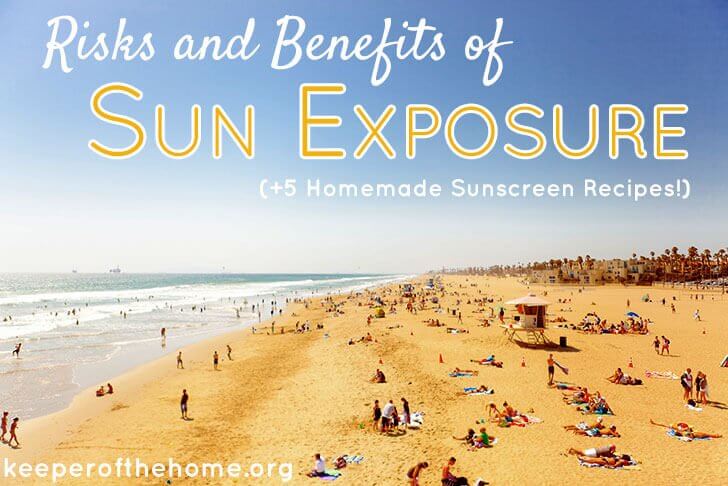
By Erin Odom, Contributing Writer
As a redhead with fair skin, sunscreen has always been a staple in my summertime skincare regimen.
The few blistering sunburns and sun poisoning that inflicted me when my parents forgot to slather it on me as a kid left a lasting impression: Going without sunscreen hurts!
But over the course of the past few years I’ve started to change my tune on sunscreen and sun exposure.
When I became aware that many Americans are deficient in Vitamin D, which we get naturally (and freely!) through sufficient sun exposure, I began to question whether or not sunscreen was always a must.
On top of that, I began to grow wary of the ingredients in most standard sunscreens on the market today. Putting potential carcinogenics on my skin to protect myself from skin cancer didn’t really make sense.
When I became the mom of three little fair-skinned redheads, I knew that I had to intentionally decide the risks and benefits of using sunscreen versus sun exposure. I didn’t want their delicate skin absorbing chemicals, but I also didn’t want to leave them open to the same blistering sunburns and sun poisoning that I remember getting as a child.
To create a balanced approach, I began investigating the benefits versus the risks of sun exposure and how to maximize those benefits and minimize those risks. I also began seeking out alternatives to conventional sunscreens.
image by Public Domain Pictures
Benefits of Sun Exposure
The sun is vital to our health. In fact, without sun exposure, we’re likely deficient in vitamin D.
Vitamin D promotes calcium absorption and is necessary for bone growth (source). Studies have also shown that maintaining proper vitamin D levels can help boost the immune system (source).
In addition, it is possible that low vitamin D levels can contribute to depression and psychological disorders!
But many Americans are deficient in this vitamin.
A few years ago my husband discovered he was vitamin D deficient. His doctor prescribed him heavy doses of vitamin D3 in an attempt to boost his levels.
I later found out that I was vitamin D deficient as well. During this time, I also experienced some thyroid problems. I had thought I had postpartum depression, but I now theorize that many of my health issues at the time could have been traced back to my vitamin D deficiency.
The puzzle pieces began coming together when I discovered that vitamin D deficiency can actually be a precursor to thyroid disease (source).
It’s difficult to get enough vitamin D solely through diet (source). My husband and I began taking about 5,000 IUs of vitamin D3 per day during the winter, and I give our girls up to 1,000 IUs per day. But perhaps the very best supplement to boost your vitamin D levels is cod liver oil.
During the warmer weather months, when we spend plenty of time outside, I cut down our supplementation to account for the best vitamin D we can get–straight from the sun.
Besides the benefits of vitamin D, sun exposure can also help improve mood (source).
image by digasalinas
Risks of Sun Exposure
Although I tout the benefits of the sun for proper vitamin D intake, I have no doubt that too much sun can be a very bad thing. I’ve witnessed it in my fair-skinned siblings and experienced it myself as a child. Blistering sunburns and sun poisoning are not something I want my children to ever experience if I can help it.
The risks of too much sun exposure include:
- dehydration,
- immune system suppression,
- eye damage,
- skin aging, and
- skin cancer (source).
So should we use sunscreen?
How can we take advantage of all the sun’s benefits while protecting ourselves–and our families–from the sun’s harmful effects?
I believe it takes an intentional approach.
Some studies indicate that slow and steady exposure to the sun over time is much safer than heavy doses of sun exposure all at once (source). A Scandinavian study of melanoma risk published in the Journal of the National Cancer Institute in 2003 found that adolescence is actually the most dangerous time to get a sunburn (source).
And could some sunscreens actually accelerate skin cancer?
A few years ago, I came across this article referencing a study that theorized that some sunscreens may actually accelerate cancer because of ingredients like vitamin A.
“…the EWG researchers found the initial findings of an FDA study of vitamin A’s photocarcinogenic properties, meaning the possibility that it results in cancerous tumors when used on skin exposed to sunlight.
“In that yearlong study, tumors and lesions developed up to 21 percent faster in lab animals coated in a vitamin A-laced cream than animals treated with a vitamin-free cream,” the report said (source).
Also, according to the The Harvard Medical School Family Health Guide, sunscreens could possibly be to blame for widespread vitamin D deficiency:
“The same DNA-damaging, sunburn-causing UVB wavelengths that sunscreens are designed to block also do some good: They kick off the chemical and metabolic chain reaction that produces vitamin D. Research shows that many people have low vitamin D levels. There is a well-documented relationship between low vitamin D levels and poor bone health. Now links have been made to everything from multiple sclerosis to prostate cancer. ‘Linking’ low vitamin D with these diseases doesn’t prove cause-and-effect, but it suggests that possibility.” (source)
I do not believe we can live our lives in fear. But my research led me to allow my three daughters–who are currently 1, 3 and 6–to get a decent amount of unprotected sun exposure while they are young. Now is the time to be slowly building up their sun exposure.
My girls play outside nearly every day. And I do not slather on the sunscreen. What has shocked me the most? My little redheaded, fair-skinned girls have not had sunburns. In fact, I burn far more easily than they do. (And my husband is a fair-skinned redhead himself, so they aren’t getting any tanning genes from him either!)
I believe the slow and steady sun exposure is already helping them not to burn–along with the mostly whole foods diet I have fed them since birth (source).
We use a natural sunscreen if we are going to be outside for an extended amount of time. (Check the EWG Skin Deep Database for safe sunscreen ratings as well as some of my personal reviews I have linked to at the end of this post.)
image by Public Domain Pictures
Minimizing the Sun’s Risks Without Using Sunscreen
It’s important to remember that there are ways to minimize the sun’s risks without using sunscreen, such as:
- seeking out shade via an awning, umbrella, tree or even hat.
- wearing swimsuits that cover a lot.
- checking yourself and family frequently for skin changes that may indicate cancerous growths.
5 Homemade Sunscreen Recipes {+ Natural Sunscreen Recommendations}
The very best way to make sure your sunscreen is safe is to make your own! Check out these 5 homemade sunscreens to get you started:
DIY Natural Sunscreen @ The Humbled Homemaker
Homemade Sunscreen Lotion @ Keeper of the Home
“Diaper Cream” Sunscreen @ One Good Thing by Jillee
Essential Oil Sun Protecting Blends @ The Encouraging Home
Homemade Sunscreen Bars @ Wellness Mama
;
Here’s my nitty gritty on all three natural sunscreens. I’ve also since discovered Lexie: Naturals and Made On sunscreens, which I personally recommend.
(Stephanie’s note: We use either my homemade recipe linked to above, or else we buy Badger Sunscreen which is fantastic, though I think Erin’s recommendations are all great choices as well!)
Were you aware of the risks and benefits of sun exposure? Have you ever tried making homemade sunscreen?
Disclaimer: I am not a medical professional. I am simply a mom who loves to research. Please conduct your own research and consult with your trusted health professional before making any decisions regarding your health. This blog is for entertainment purposes only.
Disclosure: Keeper of the Home earns a commission through purchases made through some of this page’s links. Thanks for your support of this site!

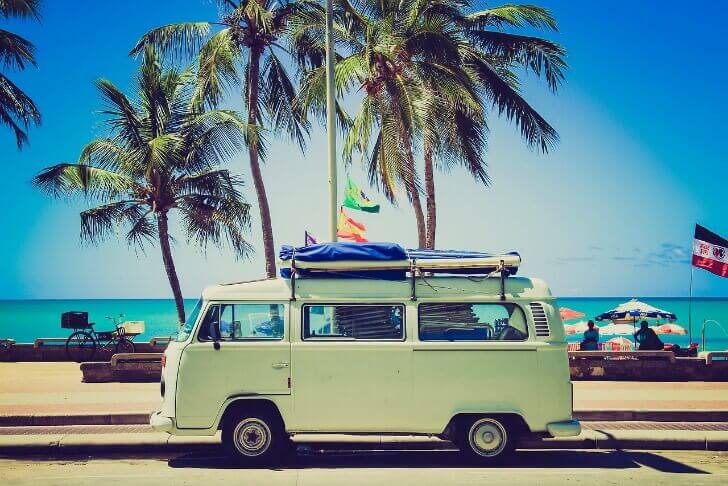
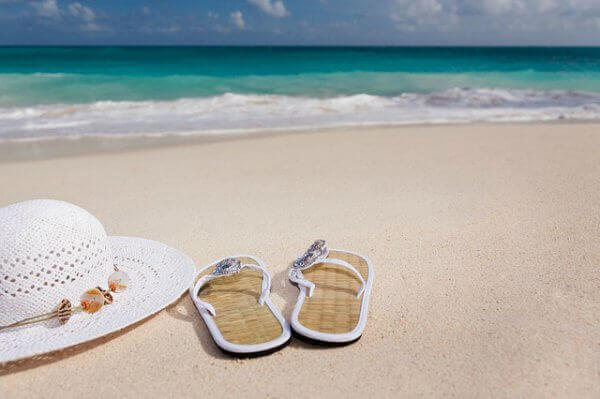
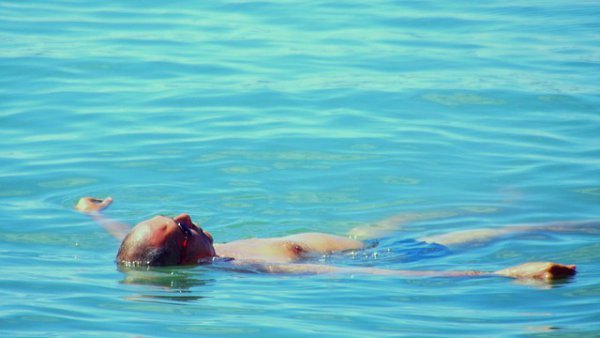

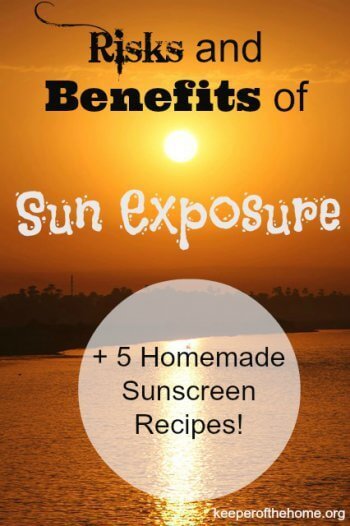

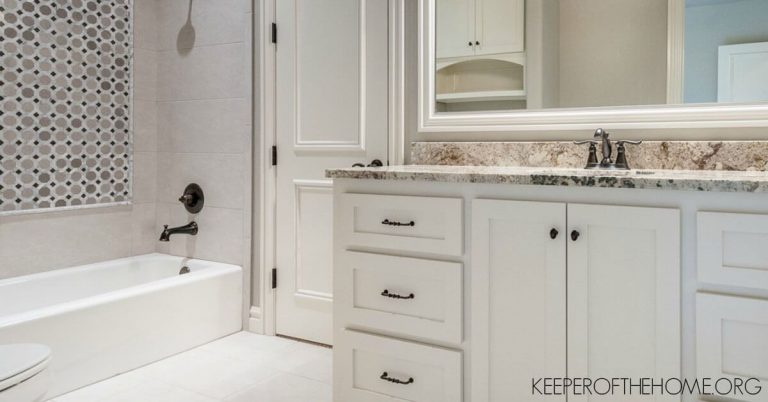
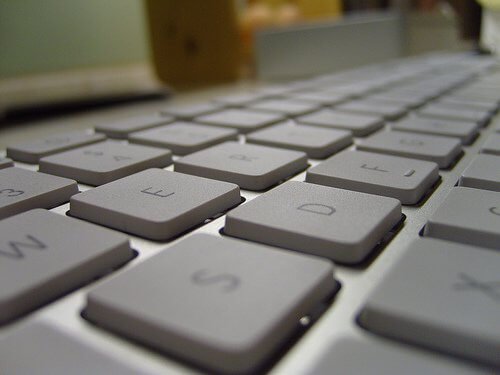

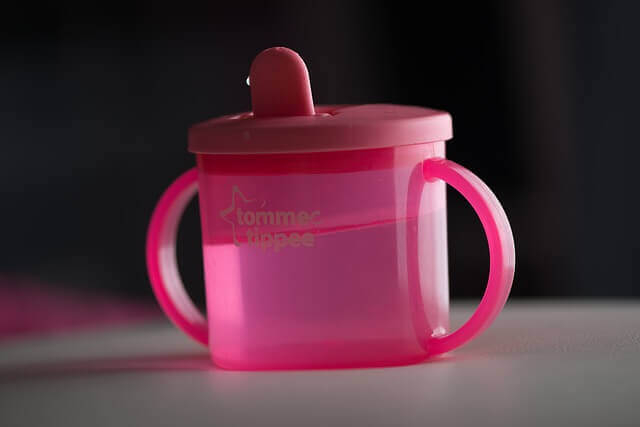
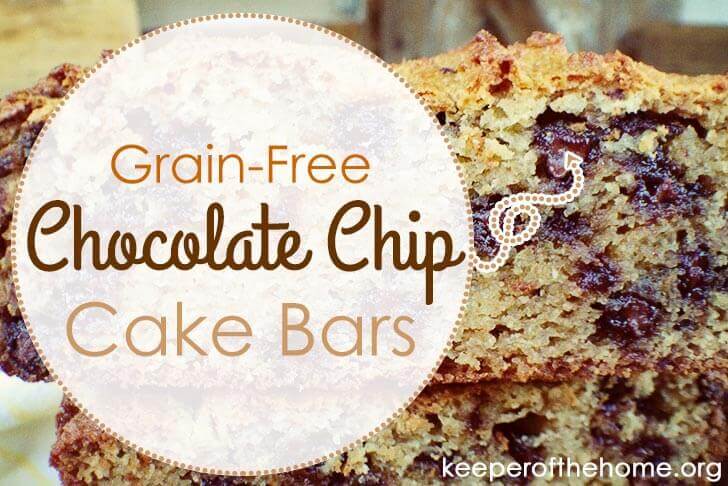
funny you should write a post about this! I was just talking to my good friend, who has had melanoma a few years ago. She is young (26). she was observing to me back, since she has drastically increased her vitamin D intake and cut way back on her sugar consumption, she has had no more skin cancer scares. And she feels better. I am a fair skinned redhead myself, and I I have noticed that I burn less now that my vitamin D levels have improved. Perhaps actually optimising vitamin D levels cuts back on one’s risk of burning in the first place!
Wow! What a testimonial! You know…I burn FAR less now than I did as a child. I wonder if it’s a combo of the built-up exposure over time, better Vitamin D levels and switching to a whole foods diet.
I recently made a batch of sunscreen following a similar recipe to the one here (it just added vit E and olive oil and in a larger batch than the posted to this website); what I found was that after it cooled there was a noticeable difference in color at the bottom as if the zinc oxide had settled while cooling. Did you notice this with any of your sunscreens and does it affect the overall coverage that it provides? I’m thinking of melting it all back down letting it solidify some, mixing with blender then re-jarring it
I would probably re-mix it. I am now using the Lexie: Naturals recipe…but she actually made it for me when I went to visit her. She’s a pro. 😉 lol
This is such an important and highly debatable topic. Thank you for all the great information and resources. This is definitely on my to-do list very soon, as I have been wanting to make sunscreen for years now. I have been using Badger brand, but it is pricey. Thanks, again, for the informative post!
I’m so glad you found it helpful, Heather!
The only people that I know who have had skin cancer were those who religiously put on sunscreen. Granted, that is about 5 people and not a true sampling of the population as a whole, but it does make you wonder. lol.
I am a natural blonde but don’t burn very easily at all. Twice I burnt bad as a teenager, being on the lake all day in California. But otherwise if I do get red at all it is gone by morning.